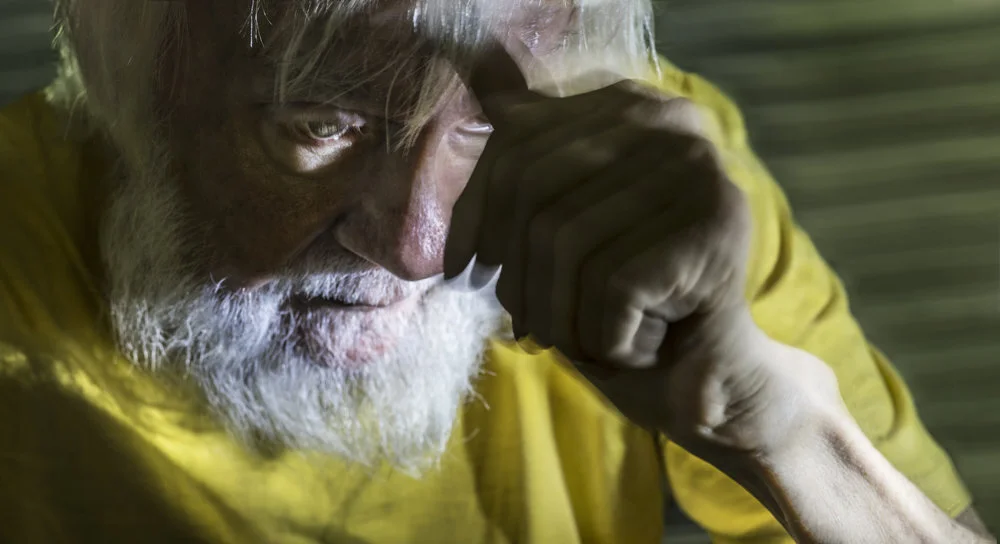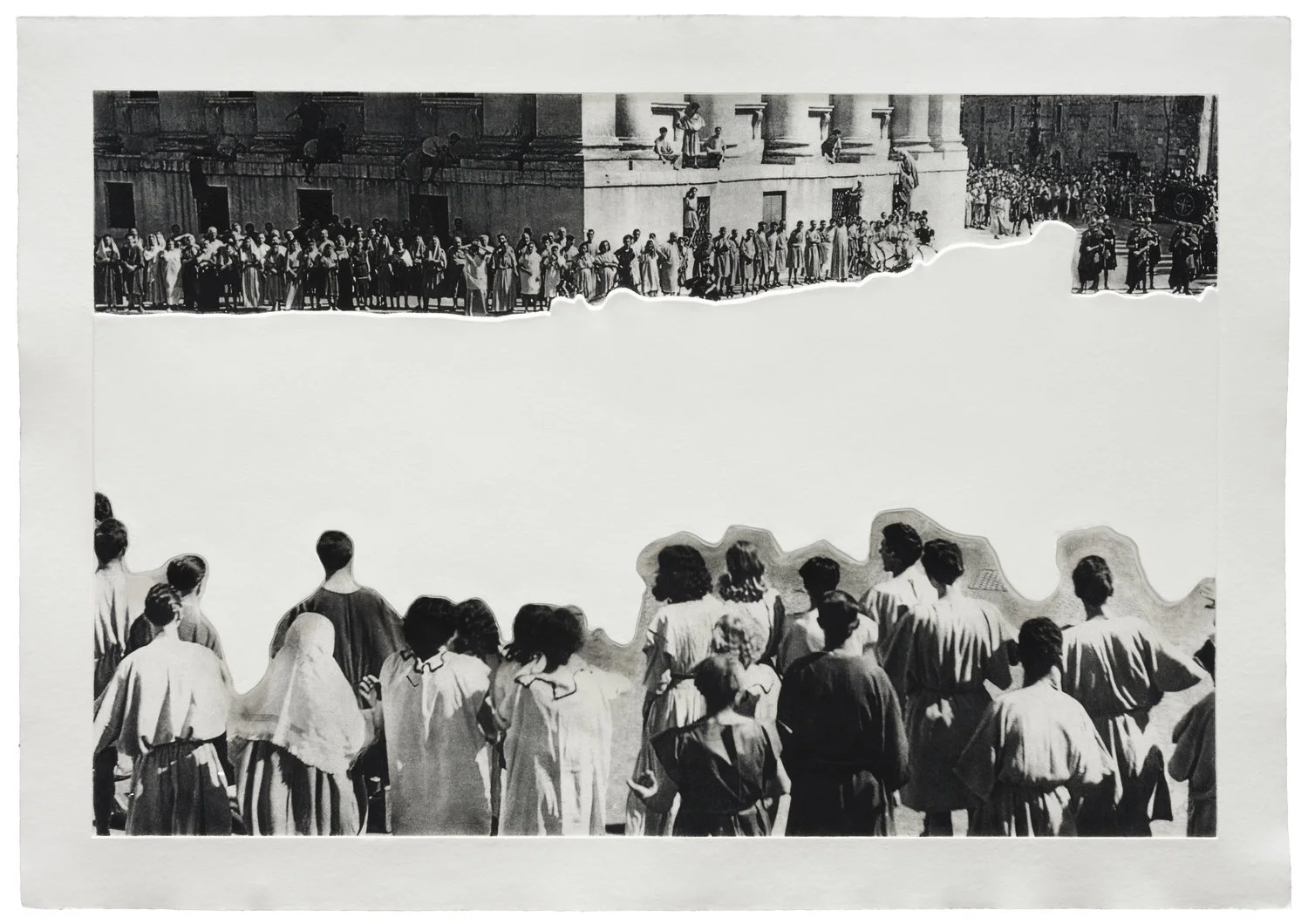From Our Archives: John Baldessari
© Michael Tighe
This interview was originally featured in our Issue 16: Chaos
Arguably one of the most important artists of the 21st century, John Baldessari has and continues to create works that disorient cultural iconography. For this issue, I specifically selected his series, Crowds with the Shape of Reason Missing, because crowds speak to chaos. Crowds create a collective energy that is unpredictable. When the “I” is submerged in the “we” and boundaries of self-hood are dissolved, people commit obscene or violent acts that they would never do on their own. But on the opposite end of the same psychology are powerful acts of solidarity, support, and empathy. Crowds strip us of our sense of self-awareness, thus de-individualizing us. This clashes with the development of our individuality, a concept that Western society has valued for centuries. We lose our personal identifiers that let us distinguish our- selves from others. We start to think and act similarly. We are engulfed by one large being, a category essentially. Within the crowd and without personal values or norms, the sense of self is thrown into a state of chaos.
ANDREA BLANCH: Let’s start with your series, Crowds with the Shape of Reason Missing. Can you speak about how this came to be? Why did you choose those particular images? Does the series have any political references?
JOHN BALDESSARI: Okay. Working backward, I don’t think any political stuff was involved. At the time, I was influenced by a book called The Shape of Crowds written by a famous Vietnamese psychiatrist. I liked the idea that crowds have a certain shape. So I had a lot of movie photographs of crowd scenes, and I just blanked out the middle--painted out the middle; it looks like what I thought was attracting the crowd. And that was it. Of course, there are no more authentic crowd scenes in film anymore, they’re all digitalized.
ANDREA: That’s intriguing. Your use of crowds in Hegel’s Cellar was fantastic.
JOHN: Yeah, and I had a reason for doing that...and I forget what it was, so I can’t tell you. [both laugh] I figured I was interested in Hegel at the time, but I don’t know why I decided to do prints. I can’t tell you.
ANDREA: I think they’re fabulous. Is there something about crowds that attract you?
JOHN: It’s kind of a frightening idea to think that you’re only a face in the crowd. It sort of eradicates identity.
ANDREA: You’ve expressed that an artist shouldn’t need to reinvent the wheel. However, you’re a serial inventor, doesn’t that get you attention and hook people?
JOHN: Well, I think that’s part of life. If you want to be an interesting person, you have to keep on reinventing yourself. I mean, imagine being at a party and you’re talking to somebody that keeps on saying the same thing. Well you’re going to walk away, aren’t you?
© John Baldessari Crowds with Shape of Reason Missing: Example 4, 2012. Mixografía® print on handmade paper, Edition of 60, 30 X 43.5 inches
ANDREA: Absolutely. I can’t imagine you’ve ever lost your identity.
JOHN: Well, no. I think that for every artist you have to sort of establish yourself as somebody that’s worthy of looking at, otherwise, nobody’s going to care about looking at your work.
ANDREA: You once said CalArts was chaotic. Were you referring to when it first began?
JOHN: It was an experimental school, our model is Black Mountain College; we gave no grades. Students didn’t have to show up for class if they didn’t want to. So it was a school in the making, so to speak--students and instructors, they created a school.
ANDREA: What would I have learned if I was a student in your class?
JOHN: I haven’t taught in years. I believe in the trial and error thing. One thing doesn’t work, you try another thing, and I remember one of the students, Matt Mullican, who is a pretty famous artist now. He did a piece where he had somebody at the entrance of CalArts with a mirror that caught the sunlight and then somebody at the door caught that sunlight and somebody else caught that until the sunlight entered our classroom and the piece was finished. That was quite inventive I think.
ANDREA: And delightful. That’s really beautiful. So how do you grab people’s attention now?
JOHN: I’m only as interesting as the work I do. Every day, there is a big load on my shoulders. I can’t be the same old same old artist. I must produce work that grabs people’s attention. That kind of dictates what I do.
ANDREA: What other artists are creative, innovative, and have garnered a lot of attention during your time?
JOHN: Well a lot of my students, like David Salle for instance.
ANDREA: Some of the devices you employ; your use of absence, eliminating the point of interest in a lot of your work captivates the audience. It makes you curious; while more importantly, makes you yearn for more.
JOHN: That’s true, I think all the works I finished now are going to be at the Marian Goodman Gallery starting November 11th and they’re about Jackson Pollock and Thomas Hart Benton, who is his teacher. The middle of the paintings are all blocked out by large rectangles of pure, white paint. You see something, but you’re de- prived of a lot of information too. The skill that has to come up with this of course you know, show a little skirt, but not too much.
ANDREA: Do you feel that this is a literary device?
JOHN: No, I think of it as a universal art concept. No artist wants to come up with “this means blah blah blah yaddah yaddah yaddah.” You have to balance; you have to be economical so people will pay attention.
© John Baldessari Crowds with Shape of Reason Missing: Example 6, 2012. Mixografía® print on handmade paper, Edition of 60, 30 X 43.5 inches
ANDREA: That addresses your preference to do things simply.
JOHN: Yes, exactly.
ANDREA: Do you think that the Crowd series is simple?
JOHN: Well I hope it’s a paradox. It’s simple and complex at the same time.
ANDREA: Well, I think it’s complex. [laughs] What led you to choose the pictures for the Crowd series? Was it the subject, or were you were able to use negative space?
JOHN: It really didn’t matter, it just had to be a generic crowd scene.
ANDREA: You’ve also said that you find the imagery to escape your own good taste. Can you explain that?
JOHN: Well I think we all hate connoisseurs that are so exquisite in their taste that we can’t stand listening to them. You’ve got to have a rougher profile than just being a connoisseur.
ANDREA: You’re selecting everything that goes into your work. That’s still a question of taste, no?
JOHN: Well yeah, but there are reasons for selecting imagery. In the history of my work, I’ve used parts of the anatomy, like a hand or a nose. A lot of times when I pick an image, it’s because in that image there’s somebody’s arm or eye that attracts me and that’s enough.
ANDREA: I went to see Hieronymus Bosch: Touched By The Devil. At the bottom of one of his paintings, there were all these eyes. “Oh my god! It’s just like John,” I thought of you right away.
JOHN: That sounds great! I’ll have to look at them.
ANDREA: Before you cremated yourself, The Cremation Project, you had already begun to do fragments of things in your work. How did this come about?
JOHN: About that same time, I had a friend who worked for a billboard company, and I asked him if I could have the leftover billboards. There’s a term in the billboard industry that’s called 24 sheet billboard, which means there would be 24 sheets of paper on that billboard to be pasted to it. Because of that, I got the idea of doing parts of things. I have 1/24th of an image, and that influenced me a lot.
ANDREA: Your lack of attachment to your work intrigues me.
JOHN: I have photos of everything, so I don’t need to own anything.
ANDREA: How do you live with chaos in your day to day life?
JOHN: [laughs] Think of all the downers.
ANDREA: [laughs] I read that you don’t like to do your bills; you don’t enjoy mundane work. Everyone can re- late to that. I saw that your studio has a lot of clutter. How does that filter into your life?
JOHN: I’m fortunate now because I can afford assistants.










